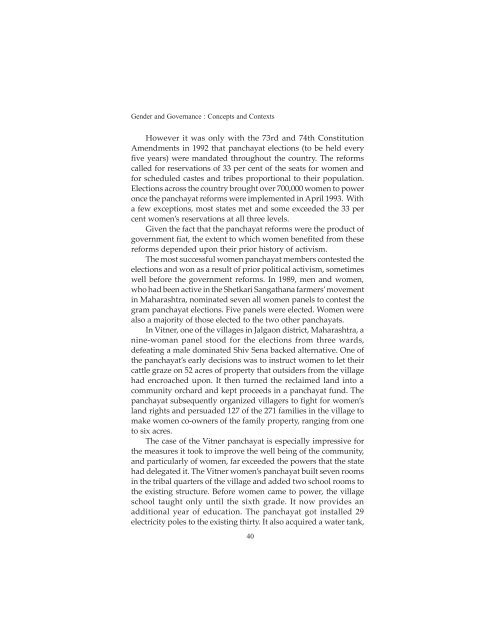Essays On Gender And Governance - United Nations Development ...
Essays On Gender And Governance - United Nations Development ...
Essays On Gender And Governance - United Nations Development ...
Create successful ePaper yourself
Turn your PDF publications into a flip-book with our unique Google optimized e-Paper software.
<strong>Gender</strong> and <strong>Governance</strong> : Concepts and Contexts<br />
However it was only with the 73rd and 74th Constitution<br />
Amendments in 1992 that panchayat elections (to be held every<br />
five years) were mandated throughout the country. The reforms<br />
called for reservations of 33 per cent of the seats for women and<br />
for scheduled castes and tribes proportional to their population.<br />
Elections across the country brought over 700,000 women to power<br />
once the panchayat reforms were implemented in April 1993. With<br />
a few exceptions, most states met and some exceeded the 33 per<br />
cent women’s reservations at all three levels.<br />
Given the fact that the panchayat reforms were the product of<br />
government fiat, the extent to which women benefited from these<br />
reforms depended upon their prior history of activism.<br />
The most successful women panchayat members contested the<br />
elections and won as a result of prior political activism, sometimes<br />
well before the government reforms. In 1989, men and women,<br />
who had been active in the Shetkari Sangathana farmers’ movement<br />
in Maharashtra, nominated seven all women panels to contest the<br />
gram panchayat elections. Five panels were elected. Women were<br />
also a majority of those elected to the two other panchayats.<br />
In Vitner, one of the villages in Jalgaon district, Maharashtra, a<br />
nine-woman panel stood for the elections from three wards,<br />
defeating a male dominated Shiv Sena backed alternative. <strong>On</strong>e of<br />
the panchayat’s early decisions was to instruct women to let their<br />
cattle graze on 52 acres of property that outsiders from the village<br />
had encroached upon. It then turned the reclaimed land into a<br />
community orchard and kept proceeds in a panchayat fund. The<br />
panchayat subsequently organized villagers to fight for women’s<br />
land rights and persuaded 127 of the 271 families in the village to<br />
make women co-owners of the family property, ranging from one<br />
to six acres.<br />
The case of the Vitner panchayat is especially impressive for<br />
the measures it took to improve the well being of the community,<br />
and particularly of women, far exceeded the powers that the state<br />
had delegated it. The Vitner women’s panchayat built seven rooms<br />
in the tribal quarters of the village and added two school rooms to<br />
the existing structure. Before women came to power, the village<br />
school taught only until the sixth grade. It now provides an<br />
additional year of education. The panchayat got installed 29<br />
electricity poles to the existing thirty. It also acquired a water tank,<br />
40

















